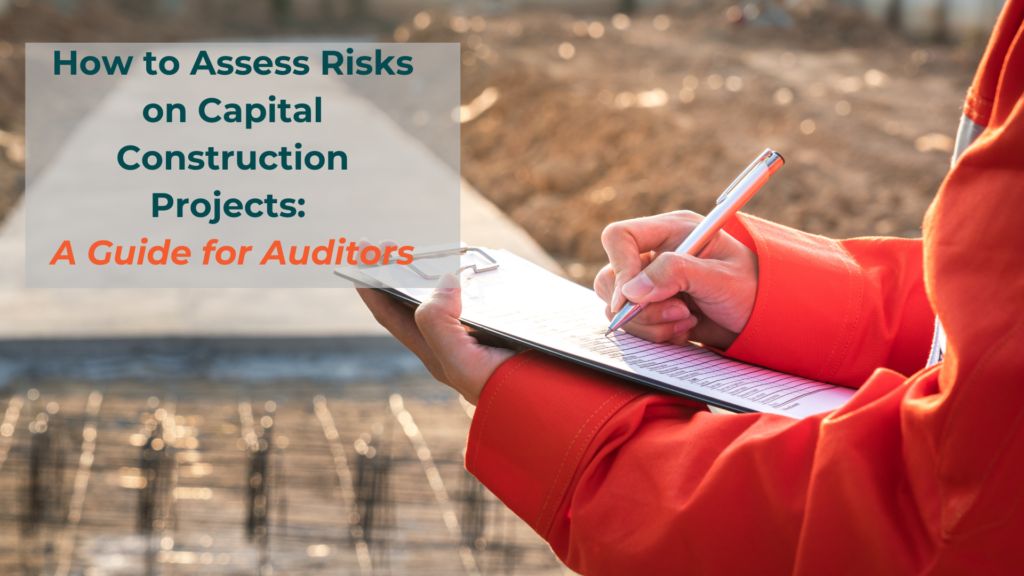
Capital construction projects are inherently complex and high-risk endeavors. Effective risk assessment is crucial for auditors to identify, evaluate, and prioritize risks, ensuring that projects are completed on time, within budget, and to the required quality standards. This guide provides a comprehensive overview of how to assess risks on capital construction projects and assign risk ratings to prioritize audits.
Understanding Risk Assessment in Construction
Risk assessment in construction involves identifying potential hazards, evaluating their likelihood and impact, and developing strategies to mitigate them. The goal is to minimize the negative effects of risks on project outcomes. A systematic approach to risk assessment helps auditors determine which projects are riskier and require more attention.
Key Criteria for Assessing Risks
Auditors can use several criteria to assess risks in capital construction projects. These criteria help in assigning a risk rating to each project, ranging from least risk to most risk. The following are key criteria to consider:
- Project Complexity
- Scope and Scale: Larger and more complex projects typically carry higher risks due to the increased number of variables and stakeholders involved.
- Technical Requirements: Projects with advanced technical requirements or innovative construction methods may face higher risks due to potential technical challenges.
- Financial Factors
- Budget Size: Projects with larger budgets are often riskier due to the higher financial stakes.
- Funding Sources: Reliance on multiple or uncertain funding sources can increase financial risk.
- Schedule and Timeline
- Project Duration: Longer projects are more susceptible to changes in market conditions, regulatory environments, and other external factors.
- Critical Path: Projects with tight schedules and critical deadlines are at higher risk of delays.
- Regulatory and Compliance
- Permitting and Approvals: Projects requiring numerous permits and regulatory approvals face higher risks of delays and non-compliance.
- Environmental Impact: Projects with significant environmental impacts may encounter additional regulatory scrutiny and potential delays.
- Stakeholder Involvement
- Number of Stakeholders: Projects with a large number of stakeholders, including clients, contractors, and regulatory bodies, are at higher risk of miscommunication and conflicts.
- Stakeholder Influence: The level of influence and interest of stakeholders can impact project decisions and outcomes.
- Site Conditions
- Geotechnical Factors: Unfavorable site conditions, such as poor soil quality or high water tables, can increase construction risks.
- Accessibility: Remote or difficult-to-access sites may face logistical challenges and higher costs.
- Historical Performance
- Past Project Performance: Reviewing the performance of similar past projects can provide insights into potential risks.
- Contractor Experience: The experience and track record of contractors and subcontractors can influence project risk levels.
Creating a Risk Assessment Matrix
A risk assessment matrix is a valuable tool for evaluating and prioritizing risks. It visually represents the likelihood and impact of each risk, helping auditors assign a risk score and categorize projects based on their severity.
- Likelihood: Assess the probability that a risk event will occur. This can be rated on a scale from low to high.
- Impact: Evaluate the potential consequences of a risk event if it occurs. This can also be rated on a scale from low to high.
- Risk Score: Multiply the likelihood and impact values to obtain a risk score. This numerical score helps prioritize risks based on their severity.
- Risk Rating: Categorize risks into levels such as Very Low, Low, Medium, High, and Very High. This helps prioritize management efforts effectively.
Assigning Risk Ratings
Using the risk assessment matrix, auditors can assign risk ratings to construction projects. The following steps outline the process:
- Identify Risks: Conduct a thorough review of the project to identify potential risks based on the key criteria.
- Evaluate Risks: Assess the likelihood and impact of each identified risk.
- Calculate Risk Scores: Use the risk assessment matrix to calculate risk scores for each risk.
- Assign Risk Ratings: Categorize projects based on their overall risk scores, assigning ratings from least risk to most risk.
- Prioritize Audits: Use the risk ratings to prioritize audits, focusing on projects with the highest risk ratings first.
Conclusion
Effective risk assessment is essential for managing capital construction projects. By using a systematic approach and key criteria to evaluate risks, auditors can assign risk ratings and prioritize audits. This ensures that high-risk projects receive the necessary attention and resources to mitigate potential issues, ultimately leading to successful project outcomes.
By joining the Institute of Construction Advisors & Consultants, you gain access to expert guidance, advanced tools, and a network of professionals dedicated to improving risk management practices in the construction industry. Together, we can build a more resilient and efficient future for construction projects.






